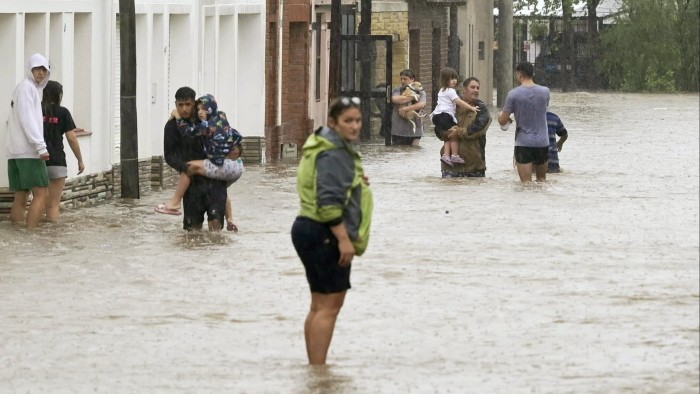The world’s first exchange traded fund investing in catastrophe bonds is set to list today on the New York Stock Exchange, opening up a potential source of returns uncorrelated to other asset classes.
Cat bonds are securities issued by insurers, reinsurers and governments to offload some of their risk from large-scale disasters. They typically offer double-digit yields, but buyers are on the hook for losses beyond a preset threshold.
Today’s launch is the latest move to expand the popular ETF format into new, often unlisted and relatively illiquid asset classes, such as private credit and equity.
The Brookmont Catastrophic Bond ETF (ILS) will hold only cat bonds linked to “randomly occurring” natural disasters such as hurricanes, wildfires, storms and earthquakes.
The bonds “deliver a low-correlation, high-yield alternative to traditional bonds at a time when investors are seeking new sources of income and diversification”, said Ethan Powell, chief investment officer of Texas-based Brookmont Capital Management.
“It’s a tremendously attractive asset class that historically has been limited to private investors. For us, the asset class has matured to such a point that it’s suitable for an ETF,” he added.
The global cat bond market has grown to $52bn, according to Artemis.bm, an analytics and data provider.
However, while a number of asset managers such as Pimco, Schroders, Amundi and a handful of specialists in insurance-linked securities offer cat bond mutual funds, up until now no ETFs have offered exposure.
This largely stems from the perceived illiquidity of cat bonds. They are typically not publicly listed, but instead are traded on over-the-counter markets, and are often held from issuance to maturity by the same owner, reducing liquidity further.
“There have always been discussions in the cat bond market around whether daily liquidity is the right thing,” said Steve Evans, editor-in-chief of Artemis.bm, who added that cat bond funds generally offered “weekly liquidity or sometimes monthly”.

“Liquidity is probably better than it has ever been, there are more bonds trading on a monthly basis, but it’s still far off from many other asset classes.”
Evans said the prevailing view in the industry was that a passive, index-tracking cat bond ETF may not work because of a lack of liquidity and market-makers, but that an actively managed, more selective ETF could succeed.
The Brookmont fund is actively managed and, Powell said, “part of what is being managed is the liquidity profile of the underlying holdings, as well as the diversification”.
If ILS does face elevated outflows at any point, “we do have the ability to have some liquidity buffers in the fund”, Powell said.
“We anticipate doing largely cash creations and redemptions, but it’s possible that we will do in-kind during stressed market situations”, meaning the specialist market-makers known as authorised participants that service the ETF would be given bonds rather than cash if they redeemed shares in ILS.
“If massive runs do occur, we think we can meet the first 20-40 per cent allocation in cash in a day or two,” Powell added.
Evans was also relatively relaxed about liquidity.
“I’m not of the opinion that they are going to have particular difficulties. They will have cash in reserve, they can invest in other types of more liquid assets. They seem to be well prepared for it,” he said.
“I don’t think they will face the same sort of liquidity problems that an index tracker might face. But it’s always very difficult to know what investors will do when there is a major hurricane brewing.”
Cat bonds currently yield about 10.5 per cent in dollar terms, according to data from Switzerland’s Plenum Investments. This consists of the insurance risk spread, derived from the premium being paid for the coverage, plus the yield generated by the invested collateral, which has risen since 2022 in line with interest rates.
This yield is net of expected losses, which have trended up in recent years, and currently sit at a little over 2 per cent, according to Plenum.
“It’s a really attractive opportunity for people to get a low teens yield with an annual impairment rate of 1-3 per cent,” Powell said. “It’s fully cash collateralised, so no credit risk, no counterparty risk and no broad economic risk.
“This is a long-term strategic allocation that will not only contribute to increased yields, but also increased risk-adjusted returns.”
Bryan Armour, director of passive strategies research, North America at Morningstar, said “cat bonds as an asset class are somewhat compelling because you get something similar to high-yields bonds but with uncorrelated risks to other bonds. It will be short duration, so from a credit risk perspective it’s very uncorrelated from interest rate risks.”
However, he questioned whether investors would understand the risks involved, given that idiosyncratic large loss events “can make performance a little lumpy”.
Armour also had concerns around liquidity, particularly if ILS became a big part of the market.
Evans agreed. “The big question is how much appetite there is going to be, and is the market deep enough to satisfy that?” he said.
ILS has a total expense ratio of 1.58 per cent and will be aimed largely at smaller institutional investors. Brookmont plans to issue a series of further ETFs designed to widen access to traditional hedge fund strategies.





